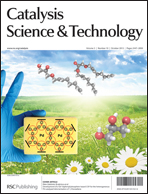The sustainable development of carbon recycling has attracted considerable attention from the viewpoint of the environment and resources. Herein, Ni nanoparticles (NPs) immobilized on a TiO2 support were synthesized via a deposition–precipitation method followed by a calcination–reduction process (denoted as Ni/TiO2-DP), which can be used as a promising heterogeneous catalyst towards CO2 methanation. Transmission electron microscope (TEM) images show that Ni NPs are highly dispersed on the TiO2 surface (particle size: 2.2 nm), with a low Ni–Ni coordination number revealed by the hydrogen temperature programmed desorption (H2-TPD) and extended X-ray absorption fine structure (EXAFS) techniques. Moreover, the catalyst with a Ni loading of 15 wt% exhibits excellent catalytic behavior towards CO2 methanation (conversion: 96%; selectivity: 99%) at a reaction temperature as low as 260 °C. The good dispersion of Ni NPs with large unsaturation facilitates a high exposure of active sites, which accelerates the formation of surface-dissociated hydrogen and the subsequent hydrogenation removal of surface nickel carbonyl species, accounting for the resulting enhanced low-temperature catalytic performance.

You have access to this article
 Please wait while we load your content...
Something went wrong. Try again?
Please wait while we load your content...
Something went wrong. Try again?


 Please wait while we load your content...
Please wait while we load your content...